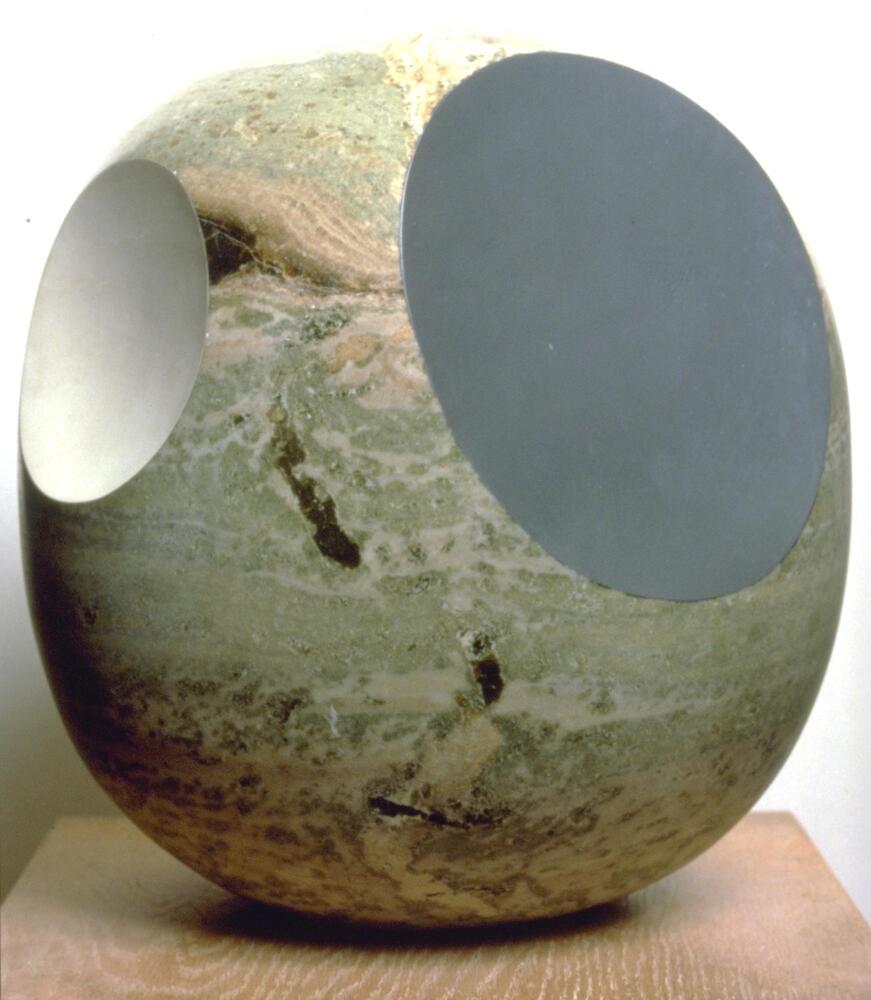Barbara Hepworth - Sphere with colour (Grey and White)
Hepworth, the Tate Gallery, Galileo and Sugar.
“Sphere with colour (Grey and White).” Barbara Hepworth (1965)
Barbara Hepworth (1903 - 1975)
As a young girl, Hepworth enjoyed going on road trips with her dad, who was a county surveyor, in his car. Very few people in England then had a car, and Yorkshire was a poor, rural area of England, where very few indeed owned a car. The fields would have been mostly ploughed by horses.
“All my early memories are of forms and shapes and textures. Moving through and over the West Riding landscape with my father in his car, the hills were sculptures; the roads defined the forms.’--https://hepworthwakefield.org/artist/barbara-hepworth/
Hepworth won a scholarship to study in Italy. When she returned, newly married, to London in 1926 she was a proponent of ‘direct carving’, the practice of carving directly into wood or stone, rather than modelling sculpture in clay for a master-craftsman to then make the finished work.
Much of Hepworth’s sculptural work is white, or sometimes black or bronze. She also made some work of hard Nigerian guaranteed wood, which was sent to her by a friend. Her work often has the theme of pregnancy or childbirth, including abstract figures with a rounded, womb-like hole. The idea of “pierced” shapes was taken up by other sculptors at the time, notably Henry Moore. Hepworth had a son by her first marriage, and subsequently triplets when married to the artist Ben Nicholson.
This sculpture, unlike Hepworth’s mainly white sculptures, is carved from striped green marble. The indents, when viewed at a distance (at least 6ft is best, you can try closing one eye) as you walk around, appear to be floating above the surface, like moons orbiting around a planet.
1964, the year before this sculpture is officially dated, was the 4th centenary of Galileo’s birth. He is famous for his use of the new technology of the telescope in observing Jupiter’s moons, Io, Europa, Ganymede, and Callisto. Hepworth had Italian friends, who could easily have written to her with letters bearing the contemporary postage stamps commemorating Galileo. Magazine articles were published at the time about new observations of Jupiter, which would have been easily visible in the night sky from her studio in St Ives, overlooking the Atlantic Ocean.
However, Sphere with colour (Grey and White) has only three moon-like indents, whereas Jupiter has four main moons, as discovered by Galileo. Returning to Hepworth’s more common theme of pregnancy and motherhood, the question arises again, why only three indents?
Hepworth, herself one of four children, had four children; three were triplets. Could this refer to the triplets? Or could it be related to her oldest son Peter, an RAF pilot who was killed in a plane crash in Thailand ten years earlier (13 February 1953)? Mourning her son, she may have felt like a planet missing one of its four moons.
Barbara Hepworth died in a fire when her studio burned down in 1975, so we will never know. It may be possible to discover one day whether this sculpture was actually begun or even completed in 1964, closer to the tenth anniversary of Peter's death, and the 400th centenary of Galileo's birth on 15th February 1564.
https://www.theartstory.org/artist-hepworth-barbara.htm
Barbara Hepworth’s daughter Sarah married Alan Bowness (now “Sir”), who was Director of the Tate museum from 1980 - 88. He had previously set up the Barbara Hepworth Museum at Hepworth’s Studio and Sculpture Garden in St Ives, which the family put under the aegis of the Tate museum in 1980. The Tate also has regional museums in Liverpool and St Ives.
Another museum, The Hepworth, Wakefield, is part of the Tate Plus program to increase public access to the arts. It opened in 2011.
The Tate Gallery was renamed for Sir Henry Tate (1819 - 1899) of the famous sugar company, now Tate & Lyle. He greatly expanded the collection of the National Museum of Art at Millbank (now the “Tate Britain”). Tate built his empire up from being a grocer’s apprentice, and expanded his fortune by buying the sugar cube patent. He was the son of a Unitarian minister, and was known as a good employer and generous philanthropist.
Part of 1 Learning Collection
<p>Hepworth, the Tate Gallery, Galileo and Sugar.</...
<p>The most Scandalous woman in Europe, - Spanish p...
Rate this Resource
AVG: 0 | Ratings: 0
& Author Notes
All Rights Reserved (Information collated by Sophie Grillet.)Last Updated
March 13, 2021 10:23 a.m.Report
Reporting Policy

